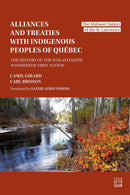Description
Co-written by Camil Girard PhD in History (Paris, Pantthéon-Sorbonne, 1982), who is an associate professor at the Université du Québec à Chicoutimi (UQAC)and; Carl Brisson a geographer and a graduate of the Master's degree in regional studies from the Université du Québec à Chicoutimi (UQAC). Foreward by Kévin Morais, Chief Councillor, Culture, Education, Health, and Finance (2016-2020), Wolastoqiyik Wahsipekuk First Nation.
The Etchemins/Amaliseet/Maliseet/Wolastoqiyik were the first—along with the Montagnais/Innu and the Algonquin/Anishinabe—to sign treaties of alliance with the French between 1603 and 1605. These treaties were motivated by the French policy of making and maintaining alliances with the Indigenous Peoples in New France to claim control over the territory and to stimulate immigration, trade, and the expansion of the colony. In 1869, following the loss of the Viger reserve lands to European settler-farmers, the Wolastoqiyik Nation was rendered scattered and forgotten. It was not until 1987, following formal recognition by both the federal and provincial governments, that the Nation was reborn.
The History of the Wolastoqiyik First Nation focuses on the socio-political evolution of nation-members from their first contact with Europeans until today. It demonstrates the ongoing resilience of the Wolastoqiyik Nation in the face of colonialism. Today, access to its territory, cultural reappropriation, and the development of economic and political autonomy are challenges that must be met to ensure the Nation’s continuity for generations to come. Knowing its history and making it accessible to both members and the non-Indigenous population is an important step toward ensuring the continual recognition of the Wolastoqiyik Nation. This book contains 90 illustrations.


